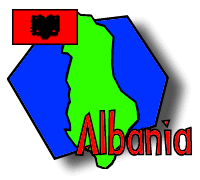Person of the Day: Angela, Mirj, and Swela
Place of the Day: National Museum of Albania
Tech Fact of the Day: Skanderbeg
Group Dispatch, April 1

Questions? Ask Padraic ![]() !
!
Return to Fast Facts
 |
 |
 |
 |
 |
|
Itinerary/ Journal |
Discussions |
About Albania |
eDscape Projects |
Scrapbook |
|
|
|
|
|
|
|
Copyright 2000 BikeAbout. All rights reserved.
